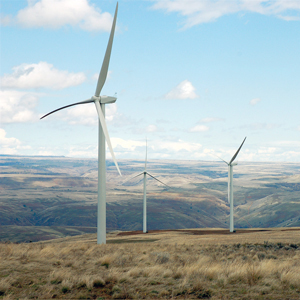 US wind power saw record purchases by corporate and non-utility customers in 2018. The year’s fourth quarter was also the third strongest for new installations on record. This comes at a time when new development frontiers are opening for offshore wind and technology advancements are making wind more economical than ever.
US wind power saw record purchases by corporate and non-utility customers in 2018. The year’s fourth quarter was also the third strongest for new installations on record. This comes at a time when new development frontiers are opening for offshore wind and technology advancements are making wind more economical than ever.By Celeste Wanner, Senior Analyst, American Wind Energy Association
Wind is a critical part of America’s energy mix, providing affordable, reliable electricity for American homes and businesses. Every year, more consumers recognise the benefits of buying wind power.
Both traditional customers and new buyers are adding wind to their portfolios and driving demand for wind. Wind purchases by corporate customers set a new record in 2018, with a total of 4,203MW of deals signed, a 66% increase over the previous record. Customers included a mix of repeat and first-time wind buyers such as AT&T, Apple and ExxonMobil. Total wind purchases by utilities and corporate buyers also reached record levels, with 8,547MW of contracts signed. Wind costs have fallen by 69% since 2009, making it the cheapest source of new electricity generating capacity in many parts of America.
With these trends, it is no surprise that the fourth quarter of 2018 was the third highest on record for new capacity, with 5,944MW installed. A total of 7,588MW was added in 2018, bringing total US wind capacity to 96,488MW, enough to power 30 million homes. And more wind is on the way with a large development pipeline of over 35,000MW.
Technological advancements that reduce costs and improve wind’s performance are helping drive this growth. Advances let modern turbines reach stronger, steadier winds, improving production and capacity factors. Notably, 2018 saw orders of the first 4MW land-based models, nearly twice the capacity of the average US turbine built in 2017. These more powerful models let developers better customise projects to their local wind resource. Technology improvements and wind-related R&D has also unlocked a vast new frontier for wind development off the coasts.
Since Block Island became the country’s first offshore wind project in 2016, coastal states have raced to gain a competitive advantage in offshore wind. Already, stakeholders are investing in infrastructure like the New Bedford Marine Commerce Terminal in Massachusetts or MHI Vestas’s $ 35 million offshore wind gearbox testing facility at Clemson University in South Carolina. Strong support from the Federal and state governments affirms the potential of America’s world-class offshore wind resource. The Bureau of Ocean Energy Management is identifying new wind energy areas, while states are adopting a suite of policies that encourage development. Much like its land-based counterpart, offshore could support thousands of quality jobs.
All of this growth is keeping American workers busy. Over 105,000 Americans work in wind, while over 500 US factories build wind-related products. In fact, wind technician is the country’s second fastest growing job according to the US Bureau of Labor Statistics and is expected to increase by 96% over the next decade.
The full extent of America’s 2018 wind power success will be on display when the American Wind Energy Association has released its 2018 Annual Market Report in April.